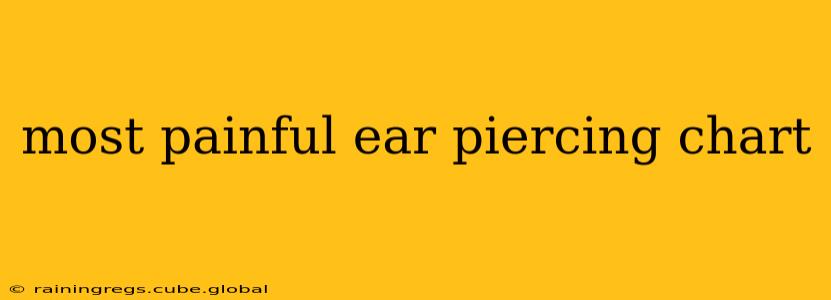Getting your ears pierced is a rite of passage for many, a way to express individuality and adorn oneself. However, not all piercings are created equal, and the pain level can vary significantly depending on the location and technique. This guide explores the most painful ear piercings, helping you make an informed decision based on your pain tolerance. We'll also address some frequently asked questions surrounding ear piercing pain.
While pain is subjective, and what one person finds excruciating another might find tolerable, consistent feedback from piercers and clients points to certain piercings being generally more painful than others. This is influenced by nerve density in the area, cartilage thickness, and the piercing process itself.
What Makes an Ear Piercing Painful?
Several factors contribute to the pain experienced during an ear piercing:
- Nerve Density: Areas with a higher concentration of nerve endings will naturally be more sensitive and thus more painful to pierce.
- Cartilage Thickness: Piercing cartilage, which is thicker and denser than the earlobe, is generally more painful and takes longer to heal.
- Piercing Technique: A skilled piercer using sterile equipment and proper technique will minimize pain and the risk of complications.
- Individual Pain Tolerance: This is a significant factor; what's painful for one person might be barely noticeable for another.
The Top Contenders for Most Painful Ear Piercings:
While the pain level is subjective, several piercings consistently rank high on pain scales:
-
Industrial Piercing: This piercing involves two separate holes in the upper ear, connected by a single bar. The cartilage is thick in this area, and the piercing process involves multiple punctures, resulting in significant pain.
-
Daith Piercing: Located in the inner cartilage fold of the ear, this piercing is known for its potential to alleviate migraines (although this isn't scientifically proven). However, the dense cartilage and proximity to sensitive nerves make it a rather painful piercing to get.
-
Tragus Piercing: This piercing is located on the small, fleshy flap of cartilage protruding from the ear. The thick cartilage and sensitivity of the area contribute to a higher pain level.
-
Rook Piercing: Situated in the inner ridge of cartilage above the anti-tragus, this piercing can be quite painful due to the cartilage's thickness and the relatively small target area for the needle.
-
Snug Piercing: Located in the small indentation above the anti-tragus, this piercing is considered quite painful due to the sensitive cartilage and the piercing technique required.
What are the Least Painful Ear Piercings?
In contrast to the above, piercings in the earlobe tend to be the least painful. The earlobe has less cartilage and fewer nerves than other parts of the ear.
Does the Pain Last?
The initial pain of an ear piercing is usually quite sharp but short-lived. The aftercare process can, however, involve some lingering soreness, swelling, and tenderness for several days. Following proper aftercare instructions provided by your piercer is crucial for minimizing discomfort and promoting healing.
How Can I Minimize Pain During an Ear Piercing?
- Choose a Reputable Piercer: Experience and skill make a difference.
- Use a Numbing Cream: Check with your piercer if a topical numbing agent is appropriate.
- Relax and Breathe: Tense muscles can amplify pain.
- Distract Yourself: Bring music, a book, or something else to occupy your mind.
What are some common aftercare tips for ear piercings?
Proper aftercare is essential for minimizing pain and complications. This usually involves:
- Cleaning: Gently cleaning the piercing with saline solution or a recommended antiseptic.
- Avoiding Touching: Keep your hands away from the piercing to prevent infection.
- Sleeping: Try to avoid sleeping on the pierced ear to prevent irritation.
Remember, everyone experiences pain differently. The best way to gauge your tolerance is to discuss your concerns with a professional piercer. They can advise you on the best piercing options based on your individual circumstances and preferences. Always choose a licensed and reputable piercer to ensure a safe and comfortable piercing experience.
